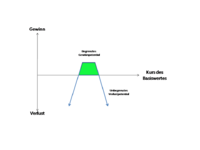Ladder (option combination)

Infinance,aladder,also known as aChristmas tree,is a combination of threeoptionsof the same type (allcallsor allputs) at three differentstrike prices.[1]A long ladder is used by traders who expect lowvolatility,while a short ladder is used by traders who expect high volatility.[1][2]Ladders are in some ways similar tostrangles,vertical spreads,condors,orratio spreads.[1][3][4]
Alongcall ladderconsists of buying acallat one strike price and selling a call at each of two higher strike prices, while a longput ladderconsists of buying aputat one strike price and selling a put at each of two lower strike prices.[1]Ashortladder is the opposite position, in which one option is sold and the other two are bought.[1]Often, the strike prices are chosen to make the ladderdelta neutral.[1]All three options must have the sameexpiry date.[1]
The termladderis also used for an unrelated type ofexotic option,[1]and the termChristmas treeis also used for an unrelated option combination similar to abutterfly.[5]
Examples[edit]
For example, a trader might construct a long call ladder by buying onecallwith astrike priceof 90, selling one call with a strike price of 95, and selling another call with a strike price of 105, all expiring on the same date. This would yield a limited loss if the options expire with theunderlyingnear or below 90, a large loss if the options expire with the underlying far above 105, and a limited profit if the underlying is near or between 95 and 105.[1]
A trader might construct a long put ladder by buying oneputwith a strike price of 110, selling one put with a strike price of 105, and selling another put with a strike price of 95 (again, all expiring on the same date). This would yield a limited loss if the options expire with the underlying near or above 110, a large loss if the options expire with the underlying far below 95, and a limited profit if the underlying is near or between 95 and 105.[1]
Ashortladder is the opposite position of a long ladder. Thus, for the first example above, the corresponding short call ladder would involve selling a 90 call, buying a 95 call, and buying a 105 call. For the second example, the corresponding short put ladder would involve selling a 110 put, buying a 105 put, and buying a 95 put.[1]
Terminology[edit]
The different types of ladders have alternative names:[4]
- A long call ladder is also called abull call ladder.[6]
- A short call ladder is also called abear call ladder.[7]
- A long put ladder is also called abear put ladder.[8]
- A short put ladder is also called abull put ladder.[9]
A ladder can be seen as a modification of abull spreador abear spreadwith an additional option: for instance, a bear call ladder is equivalent to a bear call spread with an additional long call. A bull put ladder is equivalent to a bull put spread with an additional long put. These terms can be confusing, as they do not correspond to the usual concepts of "bullish"and"bearish"in finance. For instance, abearcall ladder is in fact an overallbullishstrategy.[3]
Characteristics[edit]
A long ladder is similar to a shortstranglebut with limited risk in one direction (the downside for a call ladder and the upside for a put ladder),[1]while a short ladder is similar to a long strangle but with limited profit potential in one direction (again, the downside for a call ladder and the upside for a put ladder).[1]A ladder is also similar to acondor,the key difference being that a condor has an additional option; for example, a long call condor is similar to a long call ladder but with an extra call at a higher strike.[4]
A ladder'sGreeksare generally similar to a strangle.[1]Generally, a short ladder is long gamma, short theta, and long vega, while a long ladder is short gamma, long theta, and short vega.[1]A short ladder has limited risk and unlimited potential profit, while a long ladder has unlimited risk and limited potential profit.[6][7][8][9]
A ladder has twobreak-even points.[6][7][8][9]
Execution[edit]
Because a ladder is a somewhat complexspread,it may not be listed directly onelectronic exchanges,so traders wishing to trade one may need to make two or three transactions to construct the position, or communicate with abrokerormarket makerto specify the desired trade.[1]
References[edit]
- ^abcdefghijklmnopNatenberg, Sheldon (2015). "Chapter 11".Option Volatility and Pricing: Advanced Trading Strategies and Techniques(Second ed.). New York.ISBN9780071818780.
{{cite book}}:CS1 maint: location missing publisher (link) - ^"Ladder option".The Financial Engineer.21 May 2012.Archivedfrom the original on 14 April 2021.Retrieved17 February2022.
- ^abCohen, Guy (7 April 2005). "Chapter 3".The Bible of Options Strategies: The Definitive Guide for Practical Trading Strategies.Pearson Education.ISBN978-0-13-278207-4.Archivedfrom the original on 18 February 2022.Retrieved18 February2022.
- ^abcMullaney, Michael (29 April 2009).The Complete Guide to Option Strategies: Advanced and Basic Strategies on Stocks, ETFs, Indexes, and Stock Index Futures.John Wiley & Sons. pp. 259–260.ISBN978-0-470-47129-6.Archivedfrom the original on 18 February 2022.Retrieved18 February2022.
- ^"Christmas Tree Butterfly Call".www.optionsplaybook.com.The Options Playbook.Archivedfrom the original on 13 April 2021.Retrieved17 February2022.
- ^abc"Long Call Ladder Explained".www.theoptionsguide.com.Archivedfrom the original on 20 January 2022.Retrieved17 February2022.
- ^abc"Short Call Ladder Explained".www.theoptionsguide.com.Archivedfrom the original on 13 May 2021.Retrieved17 February2022.
- ^abc"Long Put Ladder Explained".www.theoptionsguide.com.Archivedfrom the original on 13 May 2021.Retrieved17 February2022.
- ^abc"Short Put Ladder Explained".www.theoptionsguide.com.Archivedfrom the original on 8 May 2021.Retrieved17 February2022.


